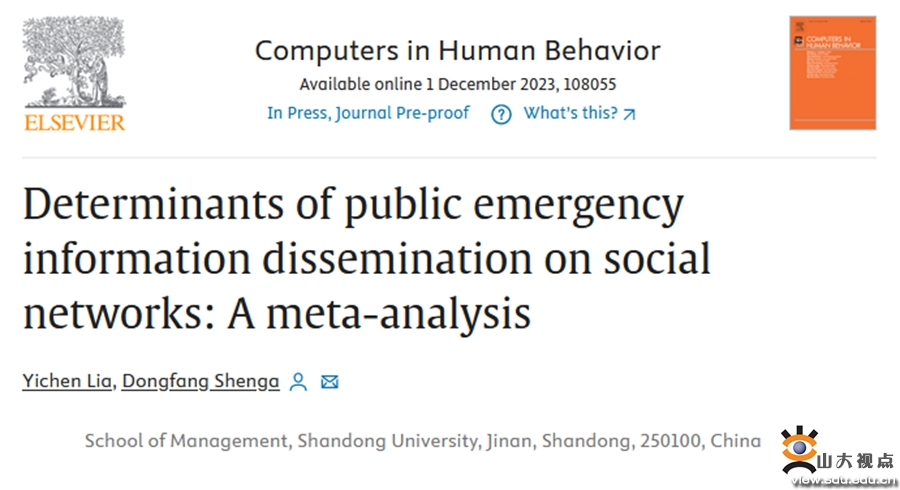Recently, Sheng Dongfang, Associate Professor of the School of Management, supervised undergraduate Li Yichen to publish a paper entitled “Determinants of Public Emergency Information Dissemination on Social Networks: a Meta-analysis” in the international journal Computers in Human Behavior (CHB). CHB is a top journal of the Chinese Academy of Sciences (CAS), JCR Q1, with an impact factor of 9.9. The journal is dedicated to the study of the use of computers from the perspective of psychology and also involves the study of the psychological impact of computers on individuals, groups and societies.

Social network emergency information dissemination is one of the key issues in the emergency management of public emergencies. The research aims to systematically integrate previous empirical studies on emergency information dissemination in social networks through meta-analysis, reconcile inconsistent findings from previous studies, propose a complete and universal research framework on the determinants of emergency information dissemination in social networks, and deepen the topic to broaden the theoretical and practical horizons. Based on persuasive communication theory, the meta-analysis integrates 21 empirical studies with a total sample size of 1,232,945 to quantify the association strength between each determinant and emergency information dissemination from three perspectives: information recipients (social motivation and affective motivation), information sources (source attractiveness and credibility), and information (affective intensity, media richness, and dialogue loops). The type of public emergency was selected as the moderating variable, and a multilevel meta-analysis was conducted to test the robustness of the results.
The results of the research have shown that, first, information recipient-related factors (social motivation and affective motivation) are the key antecedents of emergency information dissemination. Second, there is a positive correlation of smaller strength between information source-related factors (source attractiveness and credibility) and emergency information dissemination. Meanwhile, source attractiveness plays a stronger role than source credibility, and the public is more inclined to follow influential opinion leaders on social networks. Furthermore, among the information-related factors, only the emotional intensity of information shows a positive relationship of medium intensity with emergency information dissemination, which further confirms the public’s emotional phenomenon in the context of public emergencies, and the public is more sensitive to information with high emotional intensity. Finally, the results of the moderator variable analysis further indicate that in public health emergencies with contagious characteristics, the credibility of the information source, the emotional intensity of the information, and the emotional motivation of the information recipients are more closely related to emergency information dissemination in social networks. The research focuses on the emergency information management problem and puts forward reasonable suggestions for emergency management-related departments to help them be able to diffuse the network emergency information more efficiently and prevent the spread of inaccurate information, which is of great theoretical value and practical significance.
Li Yichen is an undergraduate of Supply Chain Management in the class of 2020, and the release of the academic achievement reflects the effectiveness of the undergraduate supervising system implemented by the School. In recent years, the School has been adhering to the intention of “educating talents for the country”, implementing the task of moral education, actively innovating the undergraduate cultivation mode, establishing the undergraduate supervising system, and further giving full play to the guiding role of supervisors in the cultivation, aiming to cultivate more outstanding management talents with solid basic knowledge and outstanding research ability.
Link: https://www.sciencedirect.com/science/article/pii/S0747563223004065